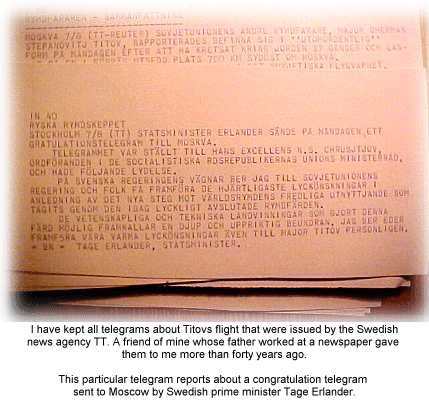 Prologue
Prologue Prologue
Prologue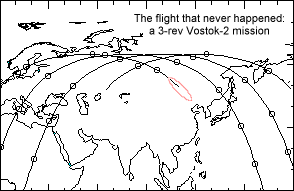 As
described in (3) plans for Vostok-2
were
sketched in early 1961 and focused on a day-long mission. In the middle
of May 1961, Korolev and the cosmonauts as well as biomedical experts
and
other officials went on vacation to Sochi on the Black Sea. Korolev
argued
for a a day long mission, while General Kamanin (director of
cosmonaut
training), the cosmonauts and doctors were more careful and thought a
three-orbit
mission should be the next step. Kamanin even called Korolev
"adventurist"
in his diaries (4). The map on the right
shows
the ground tracks for such a three-rev mission and a possible landing
zone.
However, Korolev ordered his deputy Bushuyev (later known as the Soviet
manager for the Apollo-Soyuz Test Project) to prepare for a daylong
flight.
In June, Air Force officers, physicians and cosmonauts again favoured a
three-orbit flight in a meeting with the Air Force deputy
commander-in-chief.
Korolev brought the dispute all the way to Smirnov, chairman of the
State
Committee for Defence Technology, who decided to favour Korolev's
proposal
for a seventeen orbit flight.
As
described in (3) plans for Vostok-2
were
sketched in early 1961 and focused on a day-long mission. In the middle
of May 1961, Korolev and the cosmonauts as well as biomedical experts
and
other officials went on vacation to Sochi on the Black Sea. Korolev
argued
for a a day long mission, while General Kamanin (director of
cosmonaut
training), the cosmonauts and doctors were more careful and thought a
three-orbit
mission should be the next step. Kamanin even called Korolev
"adventurist"
in his diaries (4). The map on the right
shows
the ground tracks for such a three-rev mission and a possible landing
zone.
However, Korolev ordered his deputy Bushuyev (later known as the Soviet
manager for the Apollo-Soyuz Test Project) to prepare for a daylong
flight.
In June, Air Force officers, physicians and cosmonauts again favoured a
three-orbit flight in a meeting with the Air Force deputy
commander-in-chief.
Korolev brought the dispute all the way to Smirnov, chairman of the
State
Committee for Defence Technology, who decided to favour Korolev's
proposal
for a seventeen orbit flight.
In early June, the State Commission for the flight convened and tentatively assigned Gherman Titov as the prime pilot and Andrian Nikolayev as the back-up. The launch date was et for August, a mere two months later. The detailed technical document setting out the specifics was signed by Korolev and other officials on 7 July, 1961 (3).
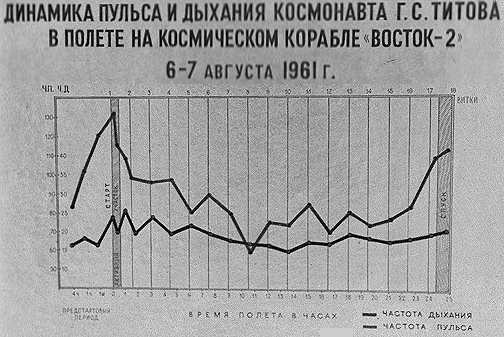 In
the middle of July, Khrushchev had invited Korolev and other aerospace
leaders to a meeting at the Crimea vacation home of the Soviet leader.
Korolev informed Khrushchev about the planned flight. Khrushchev hinted
that the flight should occur no later than 10 August (3).
It seems that this flight came to provide some propaganda cover for a
very
disturbing political event planned for 13 August, the construction of
the
Berlin Wall - the most enduring symbol of the Cold War.
In
the middle of July, Khrushchev had invited Korolev and other aerospace
leaders to a meeting at the Crimea vacation home of the Soviet leader.
Korolev informed Khrushchev about the planned flight. Khrushchev hinted
that the flight should occur no later than 10 August (3).
It seems that this flight came to provide some propaganda cover for a
very
disturbing political event planned for 13 August, the construction of
the
Berlin Wall - the most enduring symbol of the Cold War.
Immediately after entering orbit Titov felt very disoriented and uncomfortable. Titov tries to eat lunch at 0930 UT and "supper" at 1400 UT (1). When he tried to eat on the sixth orbit he vomited (3). The graph on the right shows pulse rate and respiration as a function of elapsed time (in hours). The pulse rate dropped significantly about 10.5 hours into the flight, i.e. at about 1630 UT, which was about an hour after Titov said "goodnight" to ground staff (see below).
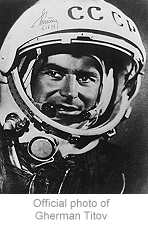 In
the official TASS announcement of the flight the radio frequencies were
given as 15.765 MHz, 20.006 MHz, 143.625 MHz for reports from the
cosmonaut
and 19.995 MHz for telemetry. The first two short-wave voice
frequencies
were amplitude modulated, while the VHF voice frequency was frequency
modulated
- and of course is still used by the Russian segment of the
International
Space Station. The VHF link was used only over the Soviet Union, while
the other channels were used everywhere else. Interestingly, a TASS
communiqué
gave unusual details about the VHF radio link. In the Pravda issue of 7
August 1961 the 143.625 MHz voice transmitter was said to be
frequency-modulated
with a frequency deviation of ± 30 kHz! Why would such technical
detail be released? Well, the flight would last quite a long time, and
many people around the world would have the chance to listen in. To
create
maximum excitement and "propaganda effect" it was essential that
listeners
outside the Soviet Union would be able to tune in, but it was also
important
that people did so, in order to avoid any claim from the West that the
whole flight was a fake! Indeed this information would probably be most
useful to professional ELINT organizations that could set their
surveillance
receivers to the correct bandwidth to get clear voice.
In
the official TASS announcement of the flight the radio frequencies were
given as 15.765 MHz, 20.006 MHz, 143.625 MHz for reports from the
cosmonaut
and 19.995 MHz for telemetry. The first two short-wave voice
frequencies
were amplitude modulated, while the VHF voice frequency was frequency
modulated
- and of course is still used by the Russian segment of the
International
Space Station. The VHF link was used only over the Soviet Union, while
the other channels were used everywhere else. Interestingly, a TASS
communiqué
gave unusual details about the VHF radio link. In the Pravda issue of 7
August 1961 the 143.625 MHz voice transmitter was said to be
frequency-modulated
with a frequency deviation of ± 30 kHz! Why would such technical
detail be released? Well, the flight would last quite a long time, and
many people around the world would have the chance to listen in. To
create
maximum excitement and "propaganda effect" it was essential that
listeners
outside the Soviet Union would be able to tune in, but it was also
important
that people did so, in order to avoid any claim from the West that the
whole flight was a fake! Indeed this information would probably be most
useful to professional ELINT organizations that could set their
surveillance
receivers to the correct bandwidth to get clear voice.
Many listening posts around the world heard Titov's voice between 0930-1000 UT (7). As Vostok-2 passed over Western Europe at about 0900 UT, two revolutions after launch, the observatory at Meudon near Paris could hear the cosmonaut's voice and Reuters' monitoring station outside London could pick up the telemetry beacon signals on 19.995 MHz. Radio specialist Sgt James Duffy in Arlington Virginia (see picture) picked up greetings in Russian from Titov to the American people. The Soviet Embassy in Washington provided a translation (7). This must have happened around 1450 UT because this was the only pass over North America before going to sleep. The frequency was either 15.765 MHz or 20.006 MHz, probably the latter. The BBC monitoring station picked up Titov's call to ground stations, his report about the temperature (22 degrees C) and his call-sign "Oriel". In (2) it is stated that Titov had to make contact on shortwaves twice an hour, regardless of position.
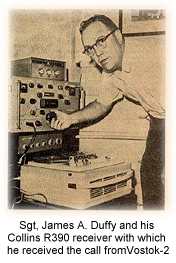 Voice
signals on shortwaves were heard weakly at 1345 UT and the
telemetry
beacon on 19.995 MHz was picked up at 1514 UT on Sunday, August 6, by
the
Råö space radio observatory near Gothenburg on Sweden's west
coast.
Voice
signals on shortwaves were heard weakly at 1345 UT and the
telemetry
beacon on 19.995 MHz was picked up at 1514 UT on Sunday, August 6, by
the
Råö space radio observatory near Gothenburg on Sweden's west
coast.
Swedish radio amateur Reimar Stridh operating from Ulvsunda in Stockholm picked up the telemetry beacon on 19.995 MHz for periods up to 20 minutes. At the pass around 1805 UT he also noted that the beacon was switched off an on (9).
The monitoring station
of
the Swedish Telecommunications Agency at Enköping near Stockholm
received
the telemetry beacon on 19.995 MHz from Vostok-2 throughout Sunday,
August
6, 1961, starting at 1000 UT and then for about 15 minutes every orbit
that the spacecraft made around the globe. The last signals for the day
were picked up at Enköping at 2241-2254 UT as the spacecraft flew
southbound over the Atlantic (9).
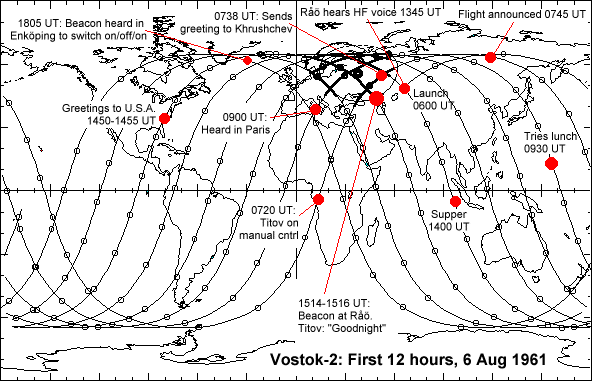
Titov transmits greetings and goodnight wishes while flying over Moscow at 1516 UT. Titov then sleeps from 1530 UT until 2337 UT. However, before going "to bed" he suffered from vertigo, nausea and headaches. Despite this Titov was able to sleep. He overslept by 35 minutes, but still felt bad. However, at the end of this twelfth orbit he began to feel better (3). The cosmonaut ate breakfast at 0245 UT.
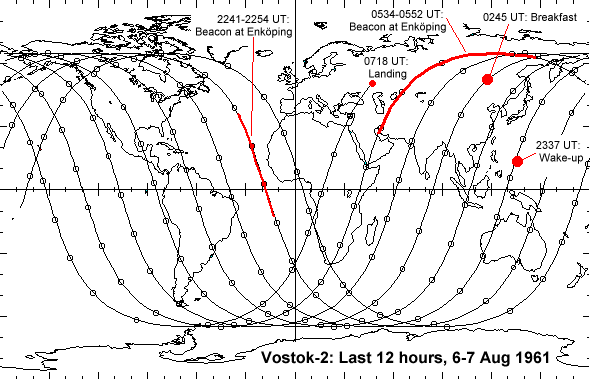
The monitoring station of the Swedish Telecommunications Agency at Enköping near Stockholm received the telemetry beacon at 0534-0552 UT as the spacecraft streaked across the launch site on its penultimate orbit around the earth (9). A Japanese monitoring station said it picked up its last signals from Vostok-2 at 0710 UT (10).
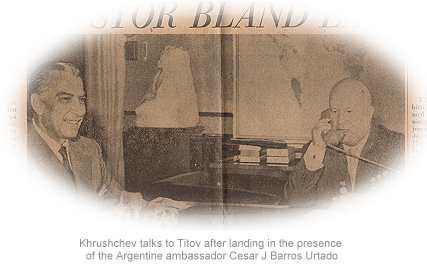 During
re-entry the instrument section of Vostok was still attached to the
spherical
re-entry vehicle by straps and Titov suffered the same nerve-racking
experience
as Gagarin. Aerodynamic heating finally severed the two modules and the
re-entry vehicle descended safely. Titov ejected from the capsule and
descended
by parachute to finally land at 0718 UT on 7 August 1961 near Krasniy
Kut,
in the Saratov district. The successful landing was announced by Radio
Moscow at 0904 UT.
During
re-entry the instrument section of Vostok was still attached to the
spherical
re-entry vehicle by straps and Titov suffered the same nerve-racking
experience
as Gagarin. Aerodynamic heating finally severed the two modules and the
re-entry vehicle descended safely. Titov ejected from the capsule and
descended
by parachute to finally land at 0718 UT on 7 August 1961 near Krasniy
Kut,
in the Saratov district. The successful landing was announced by Radio
Moscow at 0904 UT.
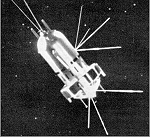 References
References